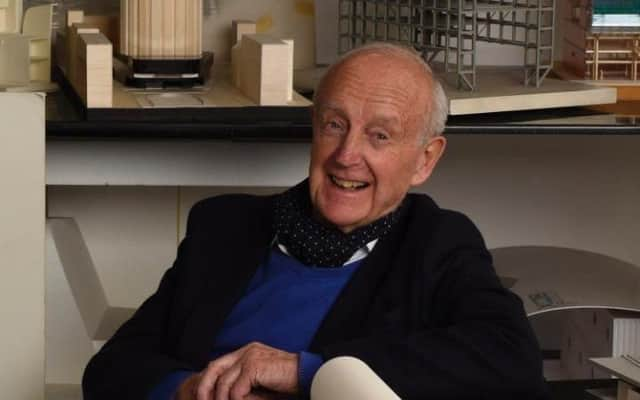Obituary: Michael Manser, architect


Michael Manser was a British architect known for his pioneering Modernist houses and for founding the Manser Medal, an annual prize given to the UK’s best new house, but is perhaps better known by some for standing-up to the profession’s detractors while president of the Royal Institute of British Architects (RIBA).
He was famously called into action when Prince Charles – speaking at Hampton Court Palace at an event in 1984 to celebrate RIBA’s 150th anniversary – compared a proposed extension to the National Gallery in London to “a monstrous carbuncle on the face of a much-loved and elegant friend”.
Advertisement
Hide AdAdvertisement
Hide AdThis would not be the first or last attack launched by the Prince over the years. The architects of the extension, Ahrends Burton Koralek, never quite recovered from the insult.
Frustrated by constant criticism of modern architecture, Manser stepped forward, becoming the guardian of the profession against what he saw, in Prince Charles’ case, as undemocratic interference from a privileged position.
Manser had a fine pedigree in introducing modern architecture and became a persuasive but always calm and considered public defender.
In 1987, the Prince declared that architects, developers and planners had done more damage to London than the Luftwaffe and called for tighter controls over the design of buildings near historic landmarks. Manser was outraged but observed: “He accuses architects of being dictatorial and then calls for controls on the style and height of buildings and the material you can use. That would stifle the freedom good architects need. It would be the surest way to bad building.’’
Born in 1929, Michael John Manser established his architectural practice in 1961, after studying at the Regent Street Polytechnic and stints working in both London and the West Indies.
He was a prolific exponent of steel-framed houses and demonstrated how the steel and glass aesthetic of the Modern Movement could be adapted to specific locations and roles.
He made his name with a series of one-off elegant, rural houses which often made skilful reuse of established landscaped settings, bringing the industrial clarity of Mies van der Rohe’s glass boxes to rural south-east England.
Manser built several notable pieces including the famous, ground-breaking Capel Manor House (1971) in Kent, which is regarded as one of Britain’s finest post-war houses and described as Britain’s answer to van der Rohe’s Barcelona Pavilion; it was Grade II llisted in 2013. Other projects included a house for his parents and his own family residence in Surrey called Golden Grove House; Larchfield Swimming Pool in Surrey (1964) and Schild House in London (1965).
Advertisement
Hide AdAdvertisement
Hide AdEschewing bricks for steel frames and glass, he became almost too well known as a designer of classy modern residences, becoming slightly pigeon-holed, when he yearned to move to a bigger scale.
Larger commissions then came, including the exposed white, metal parallelogram Hilton Hotel at Heathrow’s Terminal 4 (1990), with its sharply angled ends to let in the morning and evening sun into its vast glass atrium. The hotel has been cited by travellers such as Michael Palin and JG Ballard as one of their favourite buildings. It remains one of Hilton’s most profitable and efficient hotels.
He then designed the glass and wing-like, undulating steel framed terminal building at Southampton Airport (1994), described by the Observer as looking “magnificent from the air... interesting from the ground... and positively awesome from within”.
Commissioned by the Foreign Office, Manser produced the elegantly tropical building, which incorporated added security and bomb blast provisions, to house the diplomatic mission for the EU, Germany, the Netherlands and the British High Commission (2002) in Dar es Salaam, Tanzania. It won acclaim for responding to the climate, with sun shades and devices to encourage natural air movement through the interiors.
Perhaps somewhat ironically, Manser was also commissioned in 1990 to design the Queen’s Suite, a neat VIP reception building at Heathrow. The fact that the suite would be used regularly by the Prince was not lost on the press. Although it was unclear what Prince Charles thought, Palace sources indicated that the Duke of Edinburgh approved. This led to Manser saying: “Unlike his son, who is deeply emotional and prejudiced when it comes to architecture, Prince Philip has an open mind.”
Manser became RIBA president in 1983 and could always be relied upon to put a case for the defence when the profession was criticised. On one occasion, he accused the Prince of “architectural censorship’’ that was “killing off the heritage of tomorrow”.
He justifiably drew attention to the culpability of planners and the planning system for many of the poor buildings of the 1960s and 70s. He also garnered much support from other architects such as Sir Norman Foster and Richard Rogers.
In 2001, when Prince Charles called skyscrapers “overblown phallic structures that say more about an architectural ego than any kind of craftsmanship” and announced “anti-awards” for the worst new buildings, Manser responded that he was “so palpably over the top, it’s funny”.
Advertisement
Hide AdAdvertisement
Hide AdThe winner of a number of professional awards, Manser initially turned down a CBE in 1988, though accepted five years later.
As a writer for The Observer, Architectural Design and Home Magazine, he realised the importance of a public profile and was an articulate communicator about the qualities of modernism in an era when British society was still sceptical.
In 1953, Manser married Dolores Josephine “Jose” Bernini, an architectural writer and critic, with whom he had a daughter and son. All three survive him.
Martin Childs